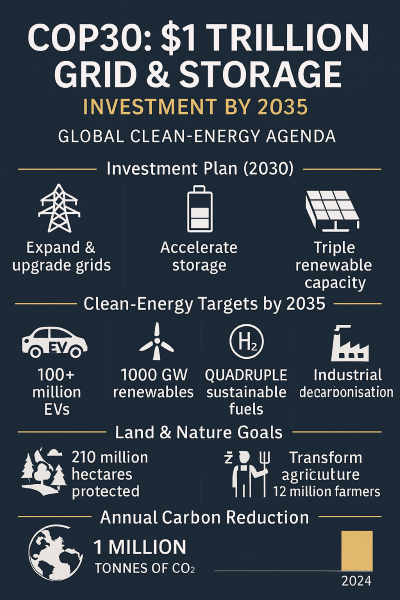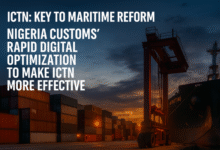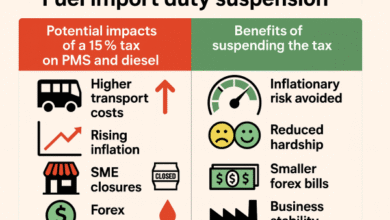COP30: Global Clean-Energy Push Targets $1 Trillion Grid & Storage Boom by 2035

The world’s clean-energy transition is entering its most consequential phase yet — and the numbers emerging from COP30 in Belém, Brazil, signal nothing short of a seismic global pivot. According to the newly released Global Climate Action Agenda Outcomes Report, nations are mobilising a projected $1 trillion investment pipeline to overhaul power grids, accelerate large-scale storage deployment, and quadruple global sustainable fuel production by 2035.
For developing countries — including Nigeria and other emerging energy hubs — this is nothing less than a historic opening. The report reveals that Global South economies are outpacing expectations in industrial decarbonisation, deploying “tens of thousands of electric vehicles, thousands of gigawatts of clean power, hundreds of low-carbon industrial projects, and frontier carbon-removal technologies.”
This is the new global energy race — and Africa is no longer merely catching up; it is accelerating forward.

The New Energy Architecture: Grids, Storage & Renewables at Triple Speed
Under the COP30 framework, three major alliances —
• Green Grids Initiative (COP26)
• Utilities for Net Zero Alliance, UNEZA (COP28)
• Clean Energy Ministerial, IRENA, IEA and global partners
— have converged on a single global plan:
➡️ Triple global renewable energy capacity by 2030
➡️ Invest $1 trillion to expand and modernise global power grids
➡️ Build grid resilience to unlock clean transportation, green hydrogen, digital electrification, and industrial decarbonisation
This grid-first strategy is vital. Without robust transmission and storage infrastructure, even the most ambitious renewable targets fail. COP30 positions grid transformation as the foundational enabler for:
- Scaling clean industrial zones
- Electrifying transport
- Expanding access to affordable power
- Enabling sustainable fuels
- Reducing global reliance on fossil systems
It is the first time a unified global technical roadmap has been endorsed at this scale.
Nature, Land & Food Systems: A Parallel Climate Revolution
Beyond the energy sector, the COP30 report outlines one of the most ambitious land-restoration and climate-resilience programmes in history:
✔️ 210 million hectares protected or restored
✔️ 12 million farmers shifting to regenerative agriculture
✔️ $9 billion committed to climate-smart food systems
✔️ Community land rights secured for millions of Indigenous, Afro-descendant and traditional groups
These initiatives form a broader climate-economy reset — transforming the global agricultural footprint, revitalising biodiversity, and protecting forests and oceans that are essential for climate balance.
Climate Resilience: Cities, Corporates & Regions Step Up
The report shows strong momentum from non-state actors:
- 437.7 million people made more climate-resilient through urban and infrastructure programmes
- 162 companies, cities, and regions slashed 850,000 tonnes of CO₂ in 2024, crossing the 1-million-tonne cumulative mark
- The CHAMP coalition (launched at COP28) delivered stronger NDCs from 78 member nations
This marks the strongest year yet for climate action outside the traditional government space.
Finance & Innovation: The New Climate Economy Emerges
The report emphasises an unmistakable shift:
“Climate action is becoming an economy of its own.”
With trillions in private and institutional capital now pivoting toward:
- Grid digitalisation
- Clean mobility
- Industrial decarbonisation
- Carbon markets
- Adaptation financing
- Climate-tech innovation
COP30 confirms the rise of a global climate-centred financial ecosystem — where nations that move quickly stand to capture disproportionate economic gains.
BRANDECONOMY Insight
What this means for Nigeria and Africa’s energy future
COP30’s trillion-dollar grid & storage plan is the clearest global signal yet that the era of fossil-dependent development is ending. For Nigeria — Africa’s largest energy market — the opportunity is immense:
- Massive investment inflows into transmission, renewable parks, storage and digital energy systems
- Acceleration of EV and clean-transport ecosystems
- Expansion of green industrial zones (steel, cement, petrochemicals, fertilisers)
- Boosted competitiveness under AfCFTA, especially for manufacturing
- Strengthened energy access and cost stability
If Nigeria aligns with COP30’s architecture, the transition becomes not a burden — but a transformative economic lever.
This is where smart policy, private-sector readiness, and global partnerships will determine winners and laggards.











